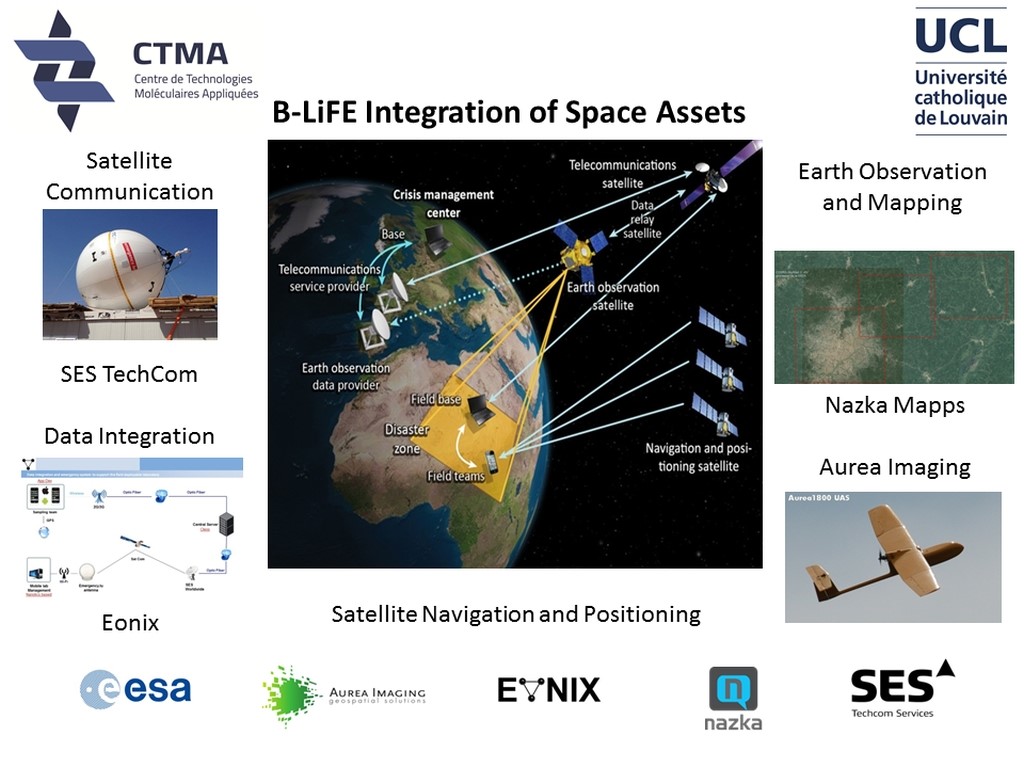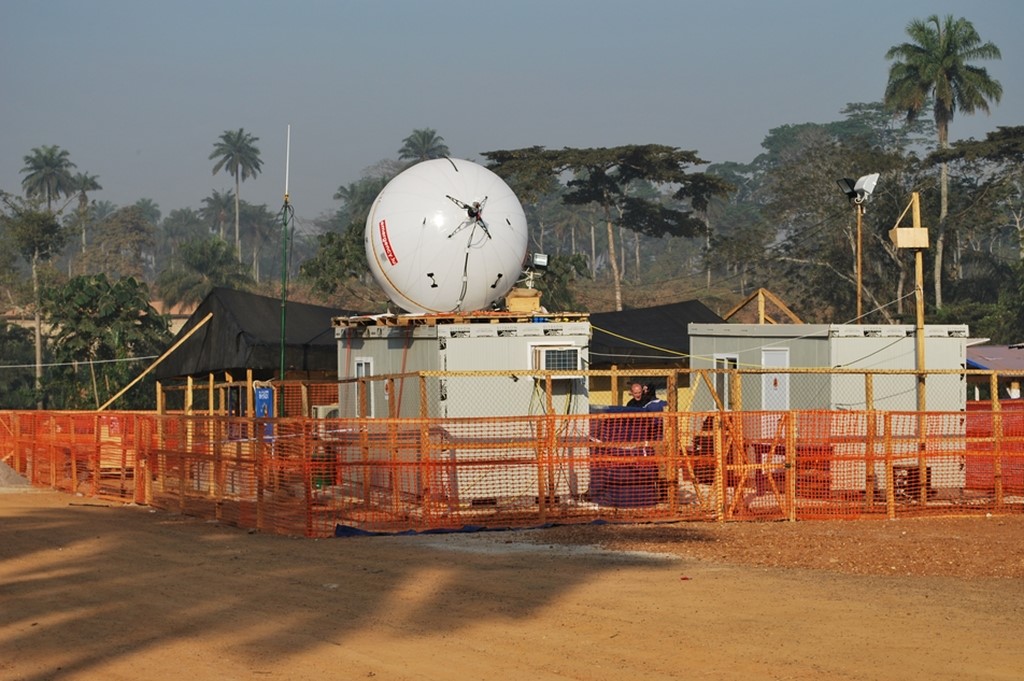
Objectives of the service
The objective of the ESA IAP-ARTES 20 « Biological Light Fieldable laboratory for Emergencies » (B-LiFE) project is to bring a diagnostic capability as close as possible to the crisis area, thus providing an essential element of fast emergency response while preserving the safety of deployed staff and of the surrounding populations.
The B-LiFE project is adding to a transportable bio-laboratory a set of space technologies and functions improving considerably the quality of the services offered: 1) satellite telecommunications to connect with the distant reach back home base laboratory, stakeholders and end users, 2) GNSS (Global Navigation satellite System) data for geo-location and Earth Observation data for site selection and monitoring.
B-LiFE has already been successfully deployed in Guinea to fight the 2014-2015 Ebola epidemics.
Users and their needs
The primary users of the B-LiFE service are the teams operating the B-LiFE laboratory, who shall benefit from the value added from the space assets during their operations.
The B-LiFE service also aims to bring benefits to a broad array of potential stakeholders/customers. These include institutions such as foreign affairs departments, cooperation offices, local governments or health or defence ministries; European and international institutions; crisis management agencies at local and international level as well as NGOs which are often lacking appropriate laboratory capabilities for disease detection and identification. National and international institutions (Health ministries, Civil Protection, WHO, DG ECHO) are among the current B-LiFE stakeholders.
The B-LiFE service provider will also target entities looking for an upgrade of their field diagnostic capabilities, such as pharmaceutical companies, food manufacturers or companies having a need for medical diagnostic capacities in remote areas, such as oil and mining companies.
In addition, B-LiFE will also address training needs as part of cooperation and development missions, for instance for local organisations willing to develop their own knowledge on-site in the field of laboratory operations in order to become more autonomous for such operations.
Service/ system concept
B-LiFE is an integrated service including a set of analytical tools able to support the provision of a rapid assessment of bio-threats present in the environment where the laboratory is deployed (e.g. Ebola epidemics in Guinea in 2015). B-LiFE is receiving information and field samples for analysis and delivers at the end the results to the customers. For an optimal interaction with the customer/stakeholder supervising the global crisis management system at distant and local level, all relevant information (i.e. medical, epidemiological, biological, etc.) are delivered in a timely manner to the right stakeholder, with accurate geo-location information and in a secured way through an autonomous and robust satellite communication system.

Fig. 1 - Integrated service for Crisis Situation © B-LiFE
B-LiFE’s added value comes from the its concept of “on-the-field analysis” rather than organising a time-consuming and hazardous transportation of samples to a distant conventional reach back laboratory.
B-LiFE services include the following:
- provision of expert analysis, identification and monitoring of B-causative agents of human or animal infections and environmental contamination and hazardous B-substances as well as scientific advice in field for all kind of operations.
- assistance in theatre-level assessment of biological threats, in order to enable end users, local and distant operational authorities (local and distant Command and Control Centres) to make timely decisions on appropriate courses of action.
B-LiFE is able to deliver the following service packages:
Space Added Value
Within B-LiFE, the following space assets are used:
Satellite Communication, for:
· Real-time communication with home base, stakeholders and families of field teams
. Real-time transmission of analytical results, reports for stakeholders and requests for logistics support
· Real-time bidirectional communication with remote medical experts
· Broadband links for large dataset transfer
Earth Observation, for:
· Geographical information and maps for laboratory site selection and monitoring during pre-deployment
. Site monitoring during the mission
. High-resolution maps for team safety and security
. Integration of Unmanned Aerial System to provide complementary data
. Epidemiological maps
GNSS
. Geolocation of samples
. Geolocation and tracking of teams and equipment deployed on the field
Thanks to these space assets, the B-LiFE laboratory can achieve greater operational performances than before and is considered as a very flexible and versatile tool, which can be rapidly deployed almost anywhere in the world.

Current Status
The B-LiFE demonstration project was presented during ESA Final Presentation Day at ECSAT, Harwell (UK) on 15 November 2017 and the outcomes of the project very positively received by the audience. The Final Review of B-LiFE successfully took place on 01 December 2017.
The B-LiFE service is now a fully operational and certified capability of the EU Civil Protection Mechanism coordinated by DG ECHO and has demonstrated his operational status during the successful Ebola mission and other deployments. B-LiFE is an important contribution for the protection of citizens during medical and humanitarian crisis.

Fig. 3 – B-LiFE Deployment in Guinea © B-LiFE

Fig. 4 – B-LiFE Laboratory in N’Zerekore © B-LiFE

Fig. 5 – Felix cured from Ebola © B-LiFE
Prime Contractor(s)
Subcontractor(s)







